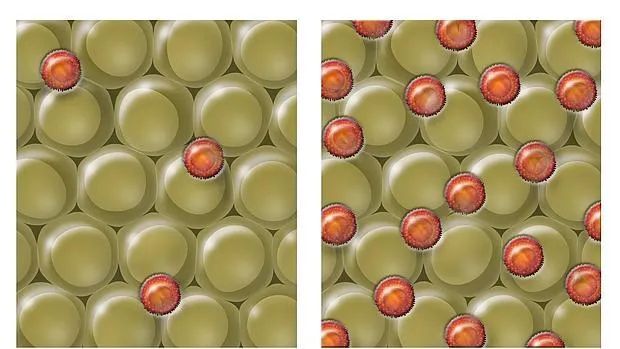Diabetes is often the result of obesity and bad decisions in the diet, but for some older people the disease could simply be a consequence of aging.An investigation that is published in "Nature" has discovered that diabetes, or insulin resistance that occurs with age, in thin mice has a different cell cause than that of diabetes that is produced by the increase in weight, the weight, theType 2 diabetes. That is, researchers Ronald Evans and Ye Zheng point out, we could be facing a new type of diabetes, type 4 diabetes.
"Many of the cases of diabetes in the elderly are not diagnosed because they do not have the classic risk factors of type 2 diabetes, such as obesity," says Evans, from the Salk Institute and main author of the new study."We hope that our discovery not only serves to design therapy, but also a greater recognition of type 4 diabetes as a different disease."
The fatty tissue is shown with representations of immune cells called regulatory T cells (orange).In age mice with diabetes (right), TREGS overexpresses in fatty tissue and triggers insulin resistance.When tregs cells are blocked, mice fat cells are insulin sensitive again.
In healthy people, the pancreas produces insulin, but in diabetics, however, this process is broken: either no insulin occurs as in response to a meal or muscle and liver cells do not respond to insulin, and occursInsulin resistance.In these two situations, sugar remains in the bloodstream for longer periods, leading to a series of health problems ranging from the loss of limb to death.
Similar to azlhéimer
There are two defined types of diabetes: type 1, which appears more frequently in childhood when the pancreas stops producing insulin, and type 2, which is characterized by the inability of the body to respond to insulin and is attributed to overweight.But there is a third type diabetes that has symptoms that mimic Alzheimer's disease.And also, it occurs in thin people.
Evans, after seeing a family member to develop this type of diabetes despite being thin, set out to find out what was happening.Thus, he compared the immune systems of healthy mice, animals with diabetes related to obesity and others with diabetes related to age.In this way they saw that mice with age -related disease had abnormally high levels of immune cells, called regulatory T cells (TREG) within their fatty tissue, while mice with type 2 diabetes had normal levels of regulatory T cellsWithin the tissue, despite having more adipose tissue.
Evans, after seeing a family member to develop this type of diabetes despite being thin, proposed to find out what was happening
"We have made a census of immune cells in the fat of these mice," says Sagar Bapat: "Simply telling the types of cells we saw that there were more regulatory T cells in the oldest mice with diabetes than any other group."
Normally, Bapat explains, TREGS cells help calm inflammation.Because the fatty tissue is constantly decomposition and construction keeps a backup that stores and releases energy, requires low levels of inflammation to constantly remodeled.But as the study suggests, the tregs cellareasInvisibles of the body, including the liver, which ends up producing insulin resistance.
Effective therapy
When the scientists blocked the TREG cells they saw that the mice did not develop type 4 diabetes. However, if the mice became obese, the blockade of the regulatory T cells in fat did not prevent insulin resistance."It turns out that for this type of diabetes, the correct treatment is not to lose weight -Evans says -but destroy these cells," and the good news is that researchers have shown that it is possible to do so, which opens a window to the treatment ofType 4 diabetes.
Researchers now want to know exactly how TREGS interacts with fatty tissue and if immune cells accumulate in other organs during normal aging.They are also planning studies to see if the results are valid in humans.


